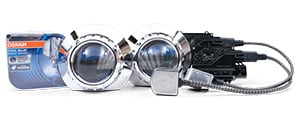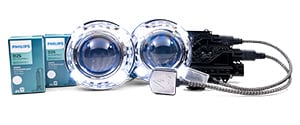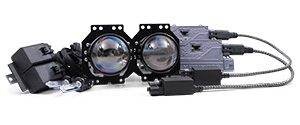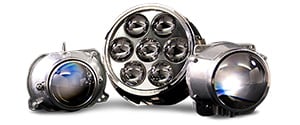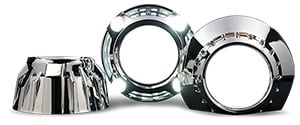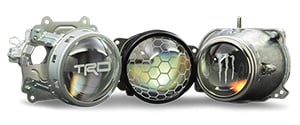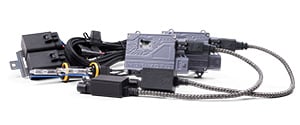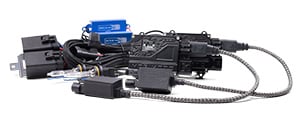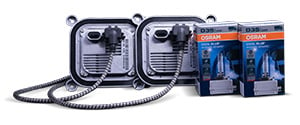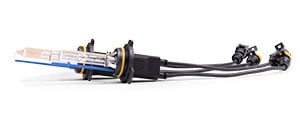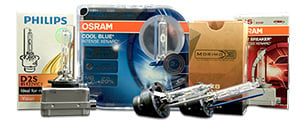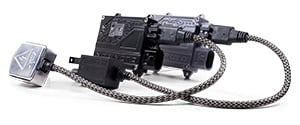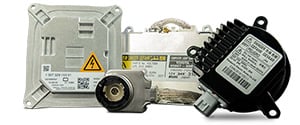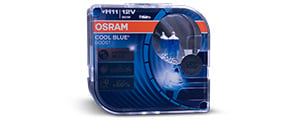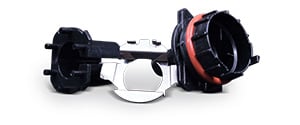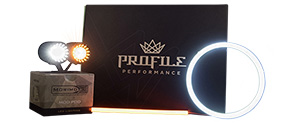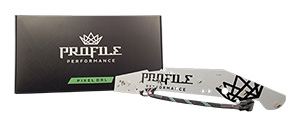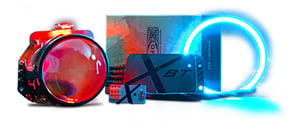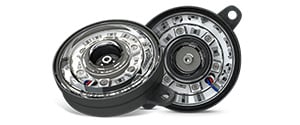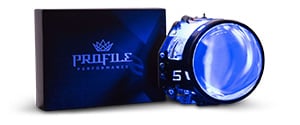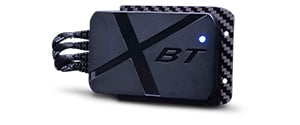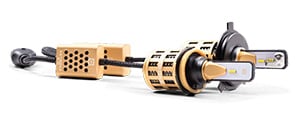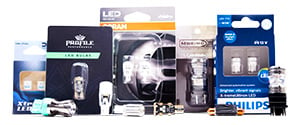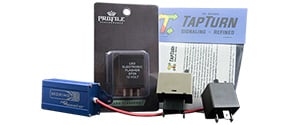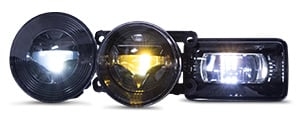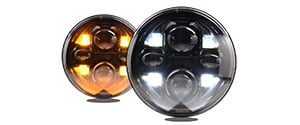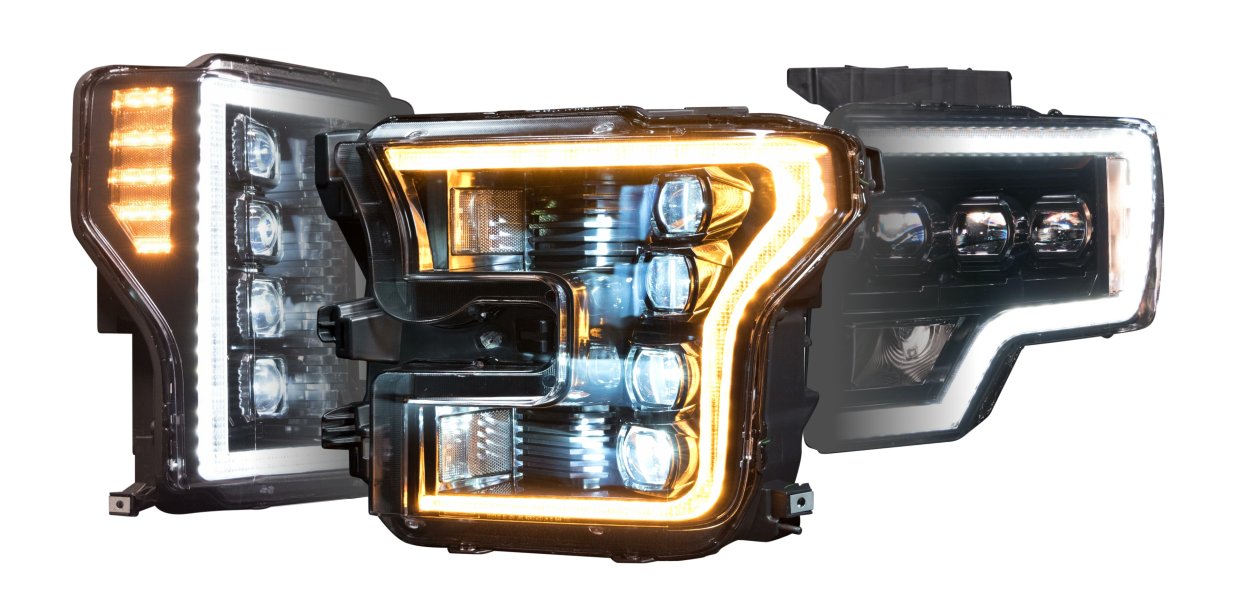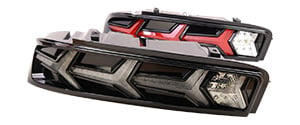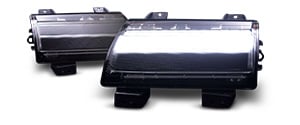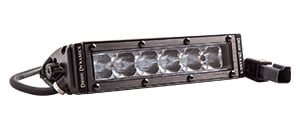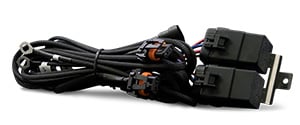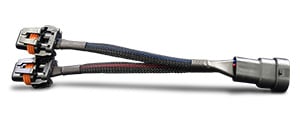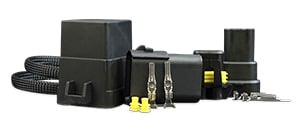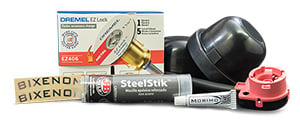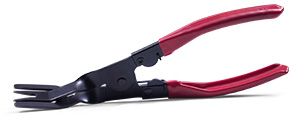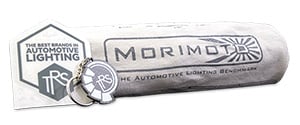In order to understand this line of reasoning, it’s important to look at the history of lighting in automobiles. Charting the rise and fall — as some people might call it — of automotive lights can help to provide a clear picture of whether a golden age has truly passed.
LATE 1800S
In the decades that preceded the introduction of the automobile, people made their private commutes in horse-drawn carriages. Even though electrical lamps were used in homes by the early 1880s, carriages were lit with lamps that were activated by a combination of oil and acetylene. Trouble is, the two main compounds of the oil-based lamp were expensive, and thus the technology for such lamps saw little development, as few investors at the time would have backed such a venture.
In 1898, the Hartford, Connecticut-based Electric Vehicle Company unveiled the world’s first electric headlamp. Alas, this new type of lamp was fraught with many of the same obstacles as its predecessor — namely, high operating costs and a lack of funding. The biggest problem with electric headlamps was the inner filament, which could singe rather quickly. Moreover, such lamps demanded electrical resources that cities couldn’t afford to develop during this period.
EARLY 1900S
As with the horse and carriage, the early automobile was limited in terms of its lighting source. The earliest cars were at first lit with kerosene oil. Soon thereafter, acetylene gas headlamps became the auto industry standard. The latter was particularly problematic for vehicles, because the light was only visible from short distances, and the gas could freeze during cold months. Consequently, it was difficult to navigate roads after dark.
Due in part to these limitations, early automobiles lacked interior lights and tail lights.
However, automotive and lighting engineers worked vigorously to develop a more satisfying system for the motor vehicle during the first few years of the 20th century. The effort initially paid off in 1908, which saw the introduction of the first carbon-based headlamp bulb to run on battery. Initially, however, the new headlamp was only available as a high-priced upgrade option to preexisting car owners.
Nonetheless, it must be stated that the history of automotive headlights truly begins during this period, because from the early 1900s onward, the race was on to make a light as conducive to, and satisfying for, motor vehicles as the light bulb had already proven to be for homeowners.
The world might have been decades away from the types of headlights that people know today, but the forward-thinking of engineers during this timeframe shows the extent to which manufacturers had a lasting vision for the automobile.
1910S
By 1911, electric headlamps had become an industry standard among U.S. auto manufacturers. The following year, Cadillac unveiled a more advanced electric headlamp that could be operated risk-free in times of downpour. The mid-1910s also witnessed the rollout of electric headlamps among European automakers.
Finally, the first headlight was introduced in 1915 by the Guide Lamp Company. However, light activation at this point still required the driver or passenger to hop and flip the lights by hand. Once again, Cadillac bested the growing technology by launching the first interior-mount control system, which allowed drivers to activate external lights from the inside.
The increased use of electric lighting in automobiles made the safety benefits of this new technology abundantly clear to lawmakers. In 1915, Massachusetts became the first state to require electric headlamps on all motor vehicles. At this same time, tail lights and brake lamps were introduced by automakers on newer car models. By decade’s end, engineers had premiered a handful of glare-reduction methods for automobile headlamps.
The introduction of interior-mount controls was this decade’s most significant development in the history of automotive headlights because it rendered car lighting less primitive and more practical for the end user. Additionally, the passage of headlamp requirements into law reveals the degree to which automotive lights had already matured, for the benefits were now readily apparent beyond the industry and motorists at large.
By this stage, automobiles had without a doubt become an integral part of society.
1920S
By the early 1920s, more states had followed Massachusetts’ lead in adopting electric-light requirements on all motor vehicles. The whole point of these laws was to improve the safety of drivers, passengers and pedestrians.
However, the new spate of laws took matters a step further: It wasn’t enough to merely have electric headlights — headlights were also now required to beam specific amounts of light, and only in specific directions. The first federally implemented standards were introduced in 1921 by the IES.
In an effort to better fulfill these requirements, engineers incorporated high and low beam options into headlights. The first cars to use this two-option lighting were rolled out in 1924.
Simultaneously, European manufacturers were developing glare-reduction features for automotive headlights. As the Roaring Twenties drew to a close, a growing number of cars were now being equipped with foot-operated dimming mechanisms.
The technological innovations of the 1920s revealed a growing awareness of the multifaceted demands that lighting entails. If automakers were to provide the best headlight bulbs for cars, it wasn’t enough to simply make lights bright and easy to operate — headlights also needed to beam at certain levels and reach specific areas.
Moreover, as necessary as it was to offer the brightest headlight bulbs that technology could allow, it was now understood that the glare must be refined, so it didn’t impose itself too heavily or even dangerously on fellow motorists.
1930S
From the outset of the Dustbowl Era, American automakers were scrambling to catch up with their European counterparts on technologies designed to reduce the glare from car headlights. Studies into the matter resulted in the adjustment of beam patterns, and hence the realization that light directed in a certain way could make things safer for drivers, and also less imposing on oncoming motorists.
As the 1930s progressed, the industry launched a slew of lighting innovations, including the replaceable glass lens, the integrated bulb and the metal reflector headlight.
1940S
As the Second World War demanded the attention of the world, car light innovations slowed, yet the auto industry witnessed one closely related development: a flashing light known as the turning signal. In 1940, new cars began rolling out with hand-activated turning signals that would automatically switch off once a turn had been completed.
As the decade advanced, turn signals became a standard feature in all American automobiles. This made it a lot easier to make left turns at four-way intersections, because a driver no longer had to manually signal fellow motorists.
Another innovation during the 1940s was the integration of automotive lighting in vehicle design, which became more streamlined and practical. Not only did lights become easier to use, but they also grew more attractive within the design framework of automobiles. From here on out, automakers produced smaller, rounder, more comfortable cars complete with optimal lighting — the likes of which are favored by motorists to this day.
In terms of how lighting was viewed within the overall driving experience, various factors came into play during the 1940s. From this point forward, the objective extended far beyond simply making the best headlight bulbs for cars.
Likewise, the expectations of drivers had by now extended far beyond the simple questions, such as “what are the brightest headlights.” Now, automakers were looking at ways to maximize light for an array of driving functions — and the development of turning signals was only the start. As such, the 1940s set the ball rolling on secondary lighting features in automobiles.
1950S
The 1950s saw further progress with the design and policies regarding sealed beam headlights. While American law required round sealed beams during the early years of the decade, automakers in Europe favored replaceable bulb headlights. The big leap forward came in 1954, with the introduction of sealed headlamps that contained a brighter filament for high and low beams.
Within three years, lawmakers green-lighted the use of separate headlights for beams of both intensities.
With these latest innovations, it was now easier to drive at all hours, day and night. Under the clear midday sun, headlights would generally be off except when parking in garages and pulling into dark areas. On rainy days, however, low-beam lights would keep each car alerted to others in close proximity on busy highways.
In the early evening, low beams were also helpful during the transition between light and dark. Later in the night, high-beam lights would make it easier for drivers to navigate dark roads.
One thing for today’s drivers to bear in mind is that the 1950s was a time where modern-day suburban development was only in its infancy. As such, drivers were greeted with far fewer paved roads or street lights, especially across the vast stretches and deep pockets of Middle America. In a sense, this relative lack of road and highway development played into the history of adaptive headlights by spurring innovations in the latter realm to compensate for the former.
As cars became more affordable among people in lower income brackets, automakers were prompted to tailor cars to the needs of a broader customer base, which now included increasing numbers of people who worked graveyard shifts or travelled great distances on a daily basis — hence the need for headlight bulb types that offered more than just one level of intensity.
1960S
The 1960s saw the slow spread of a new type of headlight that would ultimately become universal. In 1962, Italian automakers unveiled the halogen car light. Though basically an incandescent light, the new light used a small trace of bromide or iodine halogen. The result was a different composition of gas with a brighter glow.
With its ability to produce a richer quality of light without using extra power, the halogen light became popular throughout Europe due to its brightness and durability. It wasn’t long before halogen bulbs were mandatory in most of Europe.
However, the popularity didn’t extend to the U.S., where the tungsten incandescent light remained commonplace. Throughout this time, the Federal Motor Vehicle Safety Standard 108 required that all headlights be constructed of sealed beams.
The biggest shift on the U.S. lighting front during the 1960s came at the federal level. After the Motor Vehicle Safety Act of 1966, and the 1968 formation of the U.S. National Highway Traffic Safety Administration, the design of automotive lights was now in the hands of federal regulators.
By this point, cars had been a commonplace aspect of American life for three generations. As such, cars were being driven across a wider range of age groups than ever before. This expanded pool of motorists, coupled with the compacting of car designs, called for different types of headlights that suited the needs of various environments.
The demand was further spurred by the increasing number of suburban residents who commuted to big cities by day, as well as the migration of young adults to car-centric places like California.
1970S
During the early 1970s, all U.S. cars featured circular sealed beam headlights that were either dual or separate. At the request of U.S. automakers, who sought more designing liberties, federal highway laws were amended in 1974 to make way for rectangular headlamps. Within two years, the rectangular sealed beam headlamp was a common feature on newer makes and models by American car companies.
But while this did affect the appearance of the new cars, it didn’t affect the impact of the lights.
In the late 1970s, after years of resistance by American automakers, halogen bulbs began flooding into the U.S. By now, Americans had heard of the brightness and efficiency of halogen lights, which produced a fuller light than tungsten incandescent headlamps, yet used no extra power. Automakers soon caught onto how easy it was to manufacture automobiles with this low-cost lighting option.
Halogen lights swiftly became an industry standard — a phenomenon that has only recently been called into question.
In retrospect, the history of automotive headlights could be seen to have entered the last stage of its golden age around 1978, when halogen lights gained serious traction in the U.S. market. Halogen lights would dominate the auto industry for the next three decades, and remain the most familiar of the different types of headlights to most drivers.
Even though halogen lights have since been bested by newer headlight bulb types, the halogen light was the last to emerge in an era that favored quality over superficial aesthetic appeal.
1980S
The 1980s saw significant regulatory changes that expanded the automotive lighting options for American motorists. Thanks to a policy change by the U.S. National Highway Traffic Safety Administration, drivers could now choose between sealed beam headlamps and replaceable bulbs. While the latter had been used in Europe for many years, Americans were just now enjoying the luxury of headlights that could easily be changed out upon expiration.
As a result, vehicle maintenance became less costly and burdensome for U.S. car owners.
The decade also saw the replacement of glass lenses with plastic ones. Plastic offered a stronger barrier against the elements than glass, which could more easily get chipped, cracked or smashed. Now, minor impact scenarios, such as light rear-ending, could be less costly or damaging because the newer light seals were less likely to shatter than glass, which could fragment into sharp, dangerous shards.
One of the most interesting aspects of 1980s light integration was its incorporation into modernized and in some cases futuristic car designs. As young urban professionals sought cars that were sleek yet compact, practical yet edgy, automakers strove to offer the best headlight bulbs for cars in urban environments. To that end, ’80s-era cars featured headlights that were fitted and placed in a manner that was complementary to current automotive design trends.
1990S
The 1990s marked the debut of two types of lighting that have since gone on to dominate the headlight market. The first of these is the high-intensity discharge (HID) headlight, in which two electrodes support an arc of light within a tube. Commonly known as xenon headlights, HIDs were introduced in 1991, but have grown in popularity since the turn of the millennium.
HIDs are popular for their brightness, durability and energy efficiency. In comparisons to halogen bulbs, many of today’s motorists agree that xenon lights are superior by all metrics.
The other lighting innovation of the 1990s was LED lights, which consist of charged, glowing electrons. As with HIDs, LED lights can last for periods that far exceed the life expectancy of halogen lights.
Furthermore, LED lights emit strong levels of brightness without drawing too heavily on energy supplies. LED tail lights first appeared on automobiles in 1993, but the lighting option didn’t see wider adoption until the following decade. These days, LED lights are the dominant headlight type throughout the automotive industry.
With the passing of time, it’s become increasingly apparent that the 1990s marked a downward shift in car light marketing. Even though HIDs and — to a lesser extent — LED lights remain superior to all the different types of headlights that came before, the marketing of headlight bulb types was starting to emphasize “coolness” over quality.
illuminating qualities of led light have given it the market edge over brighter HID
Consequently, the icy, illuminating qualities of the LED light have given it the market edge over the brighter and technically superior HID.
THE 21ST CENTURY
In 2001, the halo headlamp first appeared as a feature of that year’s BMW 5-Series. Halo headlights consist of illuminated rings that light whenever a vehicle is in operation, day or night. Though initially an exclusive hallmark of BMW, the halo headlight has been adopted by other automakers in the years since its debut.
In effect, halo headlights function as shining rings for vehicles. As with HIDs and LEDs, halo headlights can be purchased as aftermarket replacement lights for existing vehicles.
The 2010s have seen further innovations on the lighting front, most specifically with the emergence of the laser light. The laser light works by generating concentrated light and turning it white with a lens. While the laser light has thus far been confined to luxury Audi and BMW models, the light is expected to grow in popularity in the coming years as more drivers learn of its power, durability and compact nature.
At present, the automotive market enjoys an almost overwhelming variety of headlight types. How this will ultimately play out in the history of projector headlights remains to be seen. Hopefully, automakers will relearn to balance aesthetics with quality, and not risk the latter just to boost the former for marketing purposes.
In any case, today’s drivers have their choice of the brightest headlight bulbs ever produced in the history of cars.
WHY DID THE GOLDEN AGE OF AUTOMOTIVE LIGHTING PASS?
In our humble opinion, the evolution of automotive lighting has already reached its foreseeable plateau with the passing of projected HID at the forefront of automotive lighting technology – where road illumination reached its peak in terms of brightness, efficiency and driver visibility. With no more major conceivable improvements to be made in the areas of performance, at least without major changes in regulations such as the far aging FMVSS108 standards – car lights in the 21st century have come to revolve around styling trends more than they will performance trends, at least in the US. In some cases, this has brought about dangerous roadside situations.
For example, the LED daytime running light craze has caused folks who are unaware that their headlights are actually turned off to drive at night lightless, because the daytime running light was so bright when they were pulling out of the garage that it tricked them into thinking they had their main low beams on. Off they go into the night without anything more than ambient light from their DRL’s lighting the way.
Additionally, headlights were once easy to change with a simple pop of the hood. Now, many vehicles are designed so that replacing a burnt out bulb often requires the entire front to be taken apart. Complicating things further are the presence of “tamper proof” screws, which have been added to many vehicles to make it impossible to access the service holes on the back of the headlight housing unless you have specialized tools.
UPGRADE TO HID HEADLIGHTS
Among today’s drivers, those who’ve experienced HID headlights almost unanimously concur that HID is superior to all other types of headlights. Whether your car is new or old, you can have xenon HID headlights retrofitted to beam properly from your vehicle by the team here at The Retrofit Source, where we fit replacement HIDs for various types of cars, vans and trucks.
To learn more about what we can do for your vehicle, click over right now to our products and services pages.
.png)
